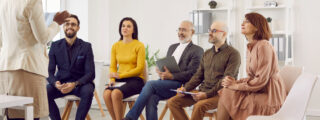
Big Blue: Explaining Blue Light to Patients
According to The Vision Council, 68.5% of Americans have never discussed digital device usage with their ECP. And 73.5% say they were not aware that eyewear is available to protect their eyes from the effects of eyestrain and exposure to blue light. To find out what eyecare professionals are doing to communicate blue light’s dangers and the solutions they offer, we checked in with three ECPs—an optician, optometrist, and ophthalmologist. As you’ll see, some talk symptoms, others science. The bottom line: Whichever direction you take, just make sure you communicate the dangers of blue light to every patient. They depend on it, and so does your bottom line.
Tip: The fact that blue light exposure affects sleep, or the lack of it, seems to be the thing they relate to most.
- Educate Patients AND ECPs. Registered optician Marty Bregman, is with Mr. Specs in Lynn, MA. He says, “I do give my patients information on blue light, telling the advantages and options for addressing it. One challenge: It is hard to demo it because it is invisible. The fact that blue light exposure affects sleep, or the lack of it, seems to be the thing they relate to most.” How does he spread the word? Beyond just patients, Bregman says, “I’ve given articles to referring M.D.’s in the area.” That’s a good way to stay in touch and share your knowledge.
- Explain Pixels AND Eyestrain. Justin Bazan, O.D., owner of Park Slope Eye and a medical advisor to The Vision Council, explains about pixels and eye strain. “The eye recognizes the distance from ink on paper.” He says. “On-screen pixels, however, are hard points of focus, and the result is that our focusing system is constantly trying to locate the pixel. That ongoing focusing results in eye strain.”
.
- Look AND Plan Ahead. Adam Berger, M.D., is an ophthalmologist, author, and blue light expert at Center for Retina & Macular Disease in Lakeland, FL. When asked last year to focus on what’s next, he replied: “In the future, eyewear will be chosen and recommended based on the percentage of blue filtration, the same way sunscreen is based on SPF values. Over the next decade, there will be more studies confirming the relationship between evening blue light exposure and disruption of the sleep-wake cycle, and increasing demand for eyewear filtering blue light in the upper end (480nm).”
What do you see ahead in your practice, and how are you preparing to move forward and research continues to deliver more concerns And more options? Please share in the Facebook conversation here.
Comments are closed.







